This post contains affiliate links.
Biology is very complex but also very visual. Interesting board games have been created – they attempt at breaking down these complex concepts into easier-to-understand pieces of information.
I found the following eleven biology board games. Most focus on a specific field of study like botany or genetics, while some are aimed at reviewing several biology topics in one game set.
Biology Board Games Comparison Table
| Game | Area of Focus | Age | Price | Players | Rating |
| Cytosis | Cell Biology | 12+ | $$$ | 2-5 | ★★★★☆ |
| Genotype | Botany, Genetics | 14+ | $$$$ | 1-5 | ★★★★☆ |
| Bunny and a Pea | Genetics | 12+ | $$$ | 2-8 | ★★★☆☆ |
| Evolution | Evolution | 12+ | $$$$ | 2-6 | ★★★★★ |
| Cellulose | Botany, Cell Biology | 14+ | $$$$ | 1-5 | ★★★☆☆ |
| Wildcraft: An Herbal Adventure Game | Botany | 4-8 | $$$ | 4 | ★★★☆☆ |
| Biology and The Human Body Curriculum Mastery Game | Human Biology | 11+ | $$$ | 1-4 | ★★★★★ |
| Scabs & Guts | Human Biology | 6+ | $$$$ | 2-10 | ★★★★☆ |
| Body Magnet | Human Biology | 7+ | $$$ | 1 | ★★★☆☆ |
| Strain: A Family Game of Competitive Bioengineering | Bioengineering | 10+ | $$$ | 3-7 | ★★★☆☆ |
| Biology Review curriculum Master Game | All the above plus Zoology | 14+ | $$$$$ | 1-36 | ★★★★☆ |
Cell Biology Board Games
Cytosis: A Cell Biology Game (Genius Games)
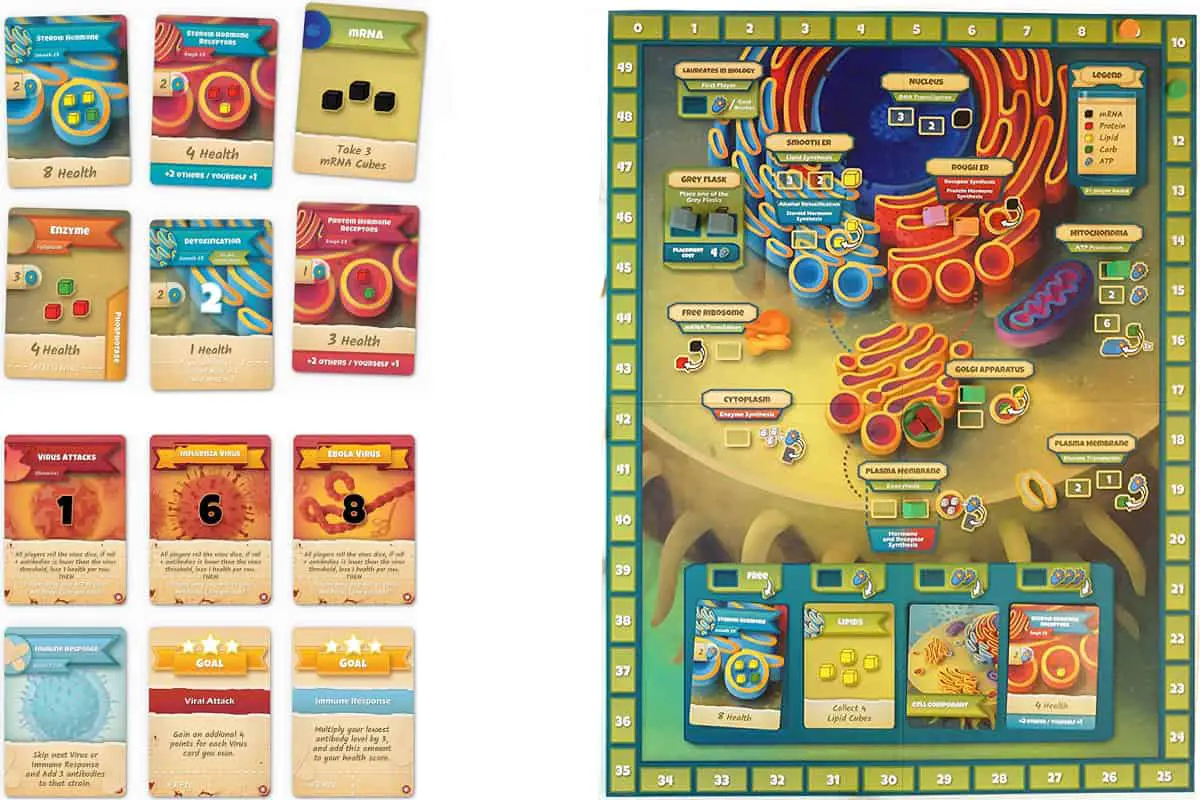
★★★★☆
For Families | Age 12+ | 2-5 players | Price $$$ | Duration 60-90 min
Cytosis is a cell biology-based “worker placement” strategy game. Its mechanism is similar to “Lords of waterdeep” but with less player interaction.
It is suitable for 12-year-olds+ board game enthusiasts (too complex for casual gamers who like simple games), as the Grade 7 science curriculum introduces the study of cell parts and their functions.
To gain points, you place your workers (flasks) on available organelles (nucleus, mitochondria) on the board to:
- Collect resources (proteins, carbohydrates, lipids)
- Build enzymes, hormones, and hormone receptors
- Perform cell functions like DNA transcription, mRNA translation, and ATP production
Cytosis can be a great complement (mostly at home) to teaching how our cells function. I like that it is:
- Purposely designed to teach cellular biology: biology notions and mechanisms are accurate
- A “real game”, not exercises turned into games, which is rare
Genetics and Evolution Board Games
Genotype: A Mendelian Genetics Game (Genius Games)
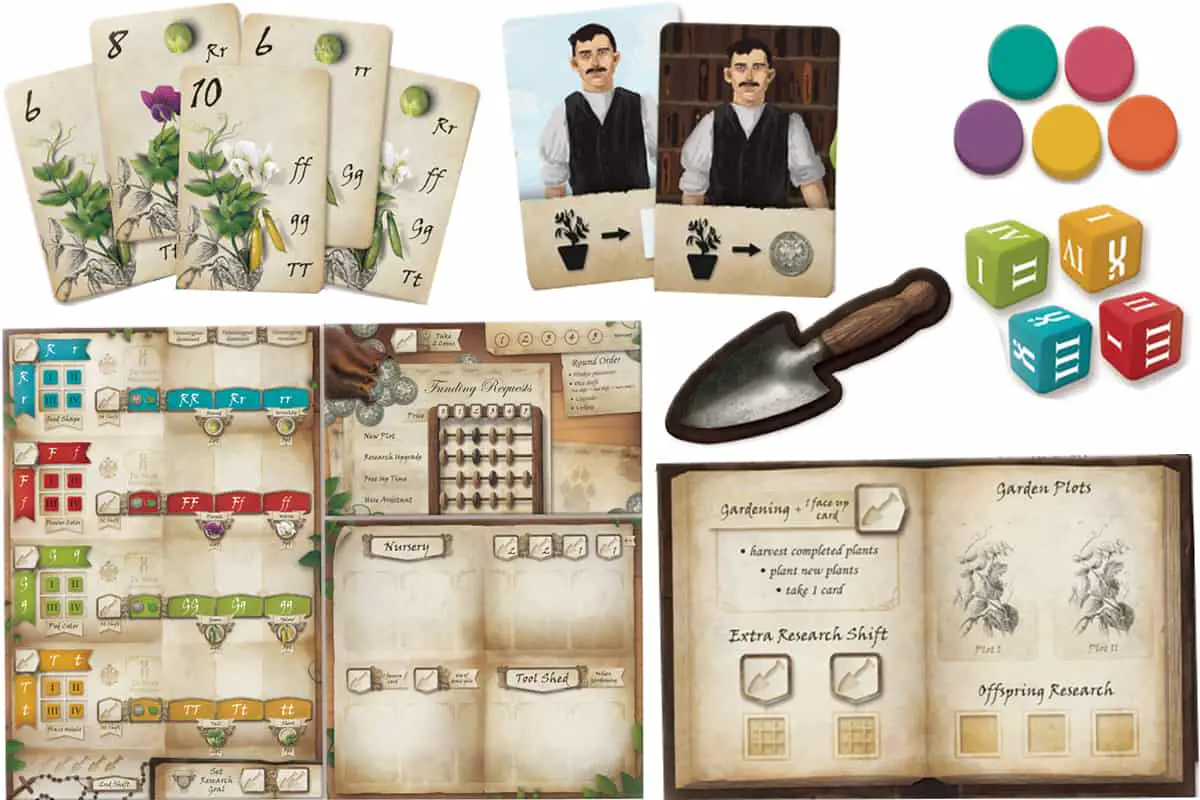
★★★★☆
For Families | Age 14+ | 1-5 players | Price $40-$50 | Duration 45-90 min
Genotype: A Mendelian Genetics Game aims to teach learners about phenotypes and genotypes and how it affects the traits of a pea plant. The person who produces the exact phenotypic characteristics of the card drawn wins.
aims to teach learners about phenotypes and genotypes and how it affects the traits of a pea plant. The person who produces the exact phenotypic characteristics of the card drawn wins.
The game starts with the players taking a card that shows the phenotype of a specific pea plant. Then, they will take turns rolling a dice to try to collect the genotype (genetic makeup) to create their plant or advance their research. There are five rounds in the game. The player who completes their card within the round limit wins the game.
This strategy game pushes players to carefully decide on every move to increase the likelihood of getting the same genes they need. It can be challenging because there are only a few rounds in each gameplay.
The manufacturer’s age recommendation is age ten and up. But it may be more appropriate for 14 and up or children with a basic understanding of genetics and the Punnett square.
Bunny and Pea (I’M Games)
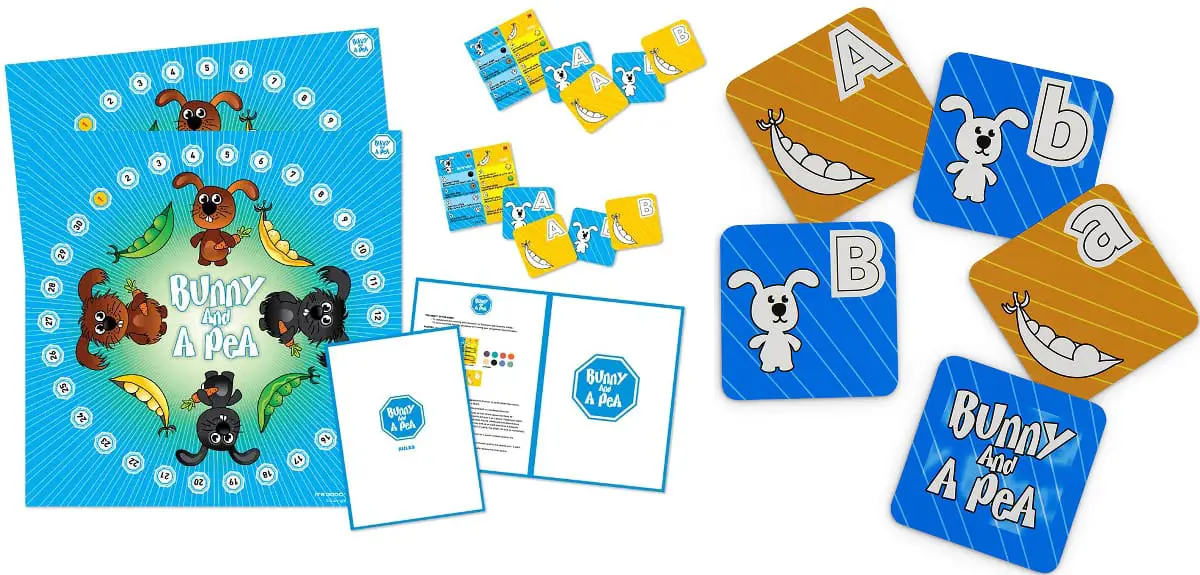
★★★☆☆
For Homes and Schools | Age 12+ | 2-8 players | Price $$$ | Duration 30 min
If you want a fun and simple way to help your learners understand heredity, then Bunny and a Pea board game are right up your alley. This board game uses bunnies and peas to teach the difference between recessive and dominant alleles.
board game are right up your alley. This board game uses bunnies and peas to teach the difference between recessive and dominant alleles.
To earn points, you need to correctly identify the image that matches the set of alleles. But before that, players have to draw a card (alleles) during their turn and place it on the surface. They will continue drawing alleles until they have a set of four matching cards (all peas or bunnies).
Once a set is completed, they will race to point to the image that corresponds to their alleles. The player who chooses the correct answer first earns two points, while the person who touches a wrong card loses two points.
You may let beginning learners of genetics refer to the hereditary variant cards to understand how alleles work. While I like the quirkiness of this game with the inclusion of bunnies, I feel like players will quickly tire of this set. This is because there are only 8 combinations available in the game.
by AM Games
Evolution (North Star Games)
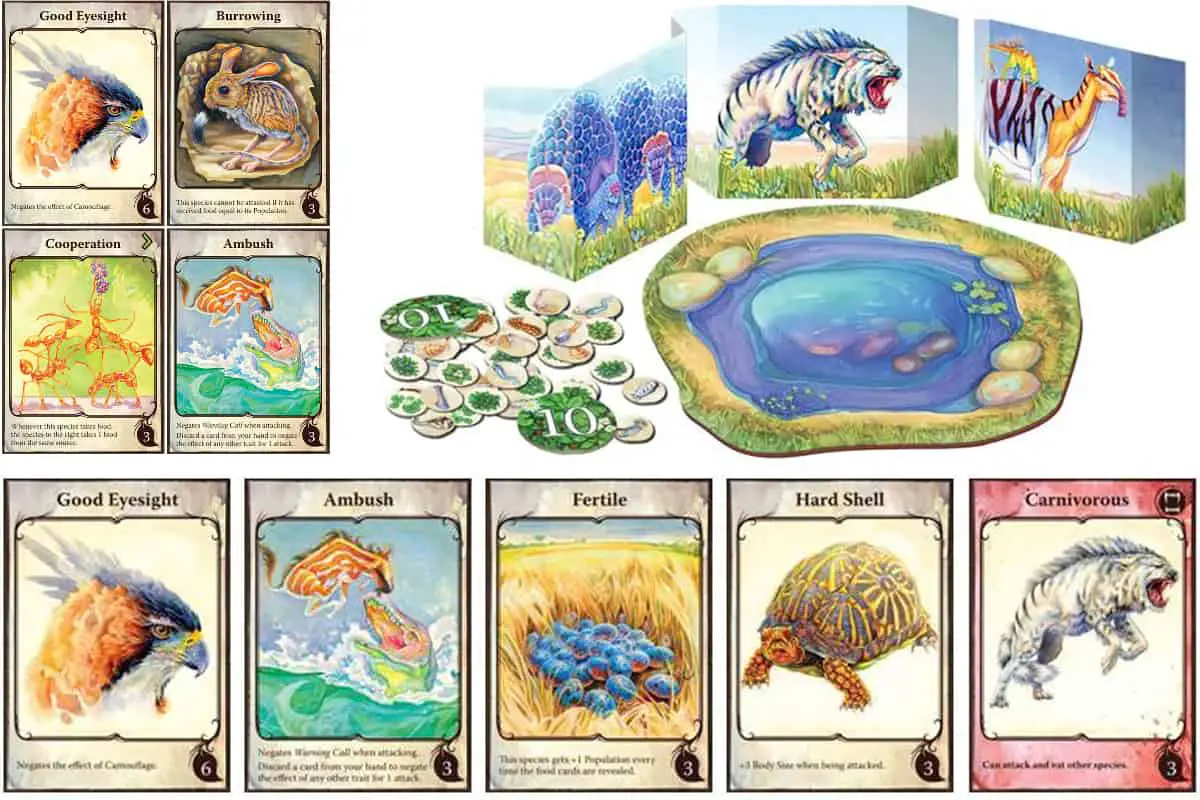
★★★★★
For Families | Age 12+ | 2-6 players | Price $$$ | Duration 60 min
Evolution by North Star Games teaches how species adapt to their changing environment. It features over 12,000 different species that players can create and develop in each adventure.
by North Star Games teaches how species adapt to their changing environment. It features over 12,000 different species that players can create and develop in each adventure.
Like in most games, the winner is the one with the most points. And to earn one, you need to outnumber and outmatch the other players in the game. There are five phases in the game, namely:
- Players are dealt 3 cards for their hand and 1 for their species board.
- Select food: players pick a trait card from their hand (to be revealed during the reveal phase) and place it on the watering hole.
- Players take turns playing the trait cards in their hand
- Reveal food: The number on these cards dictates how many foods are available during the feeding phase.
- Feeding: players take turns feeding their species. Species may go extinct if they don’t get enough food or get eaten by carnivores.
Evolution provides several ways to help your species adapt. Players have access to a lot of information about the process of evolution and the survival of species. They also learn more about the specific traits that make certain species stand out or live longer. It is easy to play so that even younger children can participate.
You can also expand your game with the Climate Conversion Kit or play in the seas with the Evolution: Oceans
or play in the seas with the Evolution: Oceans board game. Alternatively, you can print your own copy at home with the Make Your Own Copy of Evolution printable
board game. Alternatively, you can print your own copy at home with the Make Your Own Copy of Evolution printable .
.
Plants and Animals Board Games
Cellulose (Genius Games)
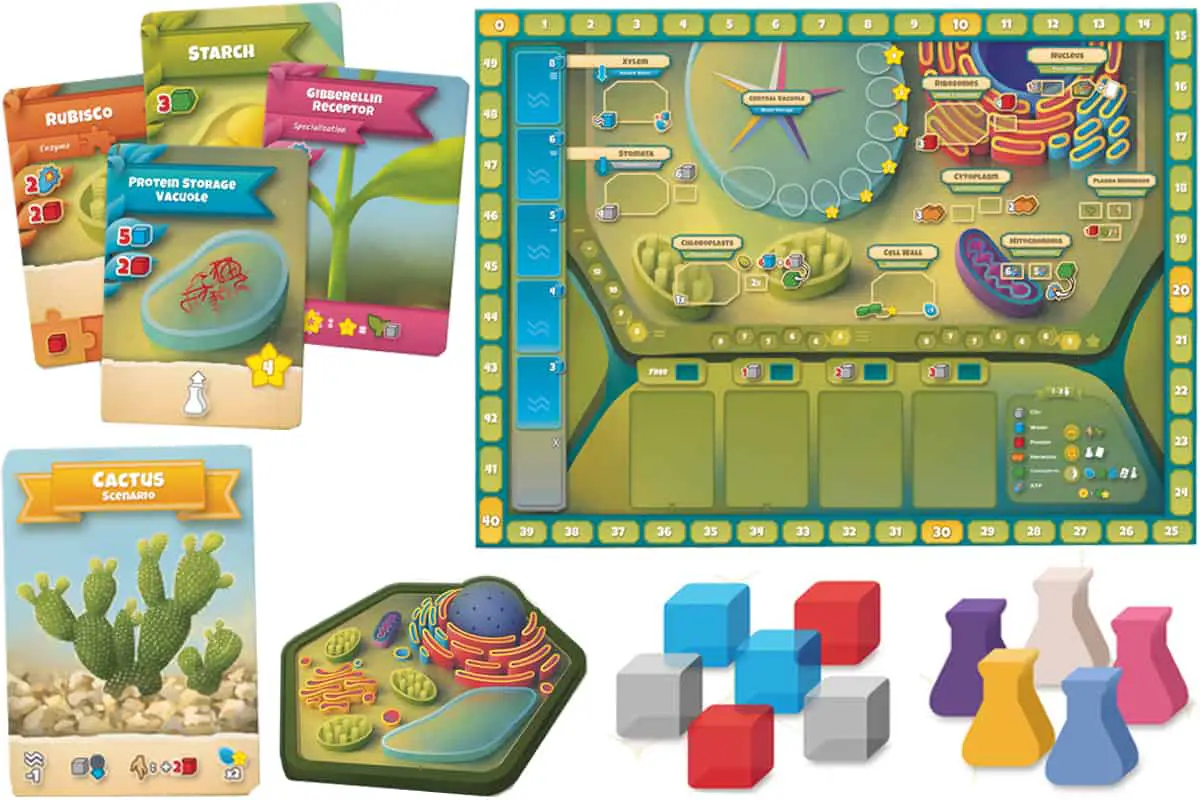
★★★☆☆
For Families | Age 14+ | 1-5 players | Price $$$$ | Duration 45-90 min
Cellulose focuses on plant development. Its goal is to finish building the plant cell wall first and score the highest points.
focuses on plant development. Its goal is to finish building the plant cell wall first and score the highest points.
The game takes place inside a plant cell. Players take turns activating organelles to aid in the growth of the cells. They compete for limited resources like water and carbon dioxide and perform different plant functions to score points.
The game changes phase per round, including sunrise, daytime, and evening. Tasks vary from phase to phase, so the players need to strategize to get the most points and additional benefits in each round.
Cellulose teaches plant cell function really well. However, the odds of winning are higher for the first player and lower for the last player because there are limited resources, and the first player has more resources than the last one.
Wildcraft! An Herbal Adventure Game (Learning Herbs)
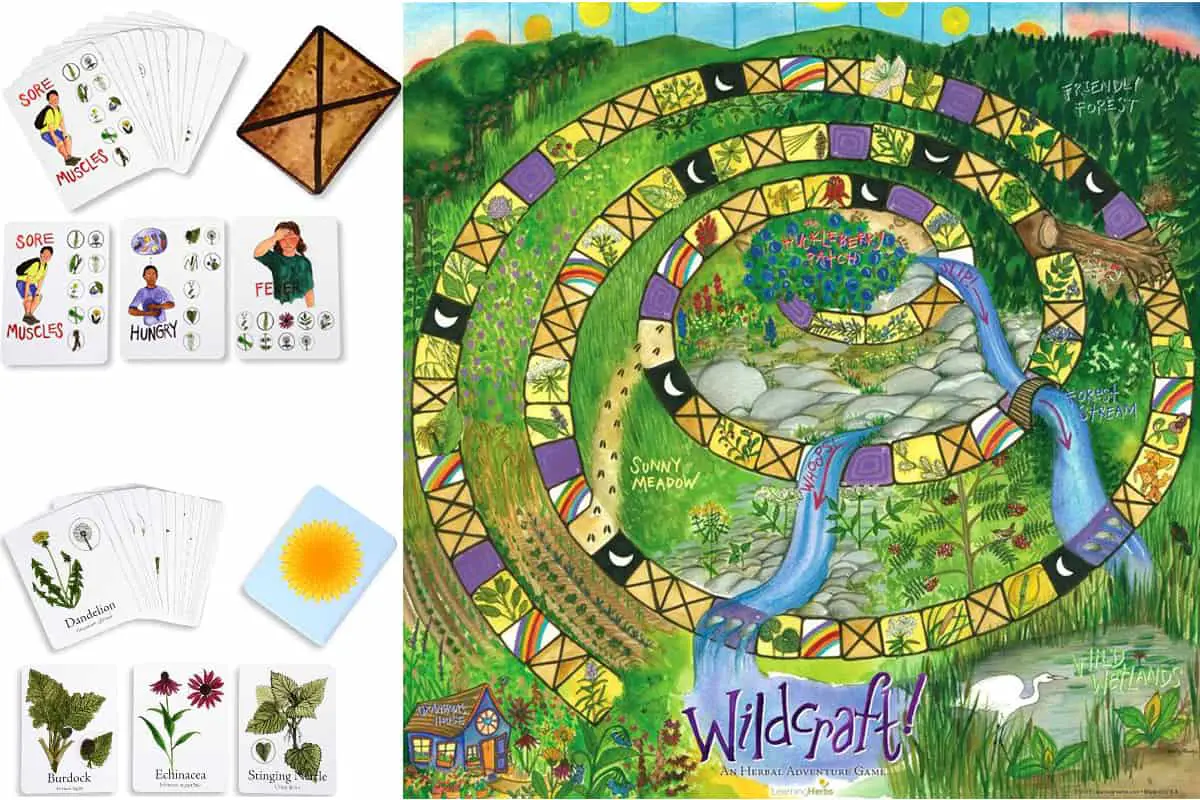
★★★☆☆
For Families and Schools | Age 4-8 | 4 players | Price $$$ | Duration 45-90 min
Wildcraft! An Herbal Adventure Game is a cooperative game that teaches children about edible and medicinal plants in a fun way.
is a cooperative game that teaches children about edible and medicinal plants in a fun way.
Players work together to climb a mountain. They need to match 25 medicinal plants (belonging to different ecosystems) to diseases or problems they cure to progress along the way.
Wildcraft engages children to learn about plants and nature and to explore the outside to actually check for plants they know. However, the set does not include a booklet that explains the plants of the game. You will need to check the website for plants, print them for future reference, or buy a reference book about herbal plants.
Human Biology Board Games
Biology and The Human Body Curriculum Mastery Game (NewPath Learning)
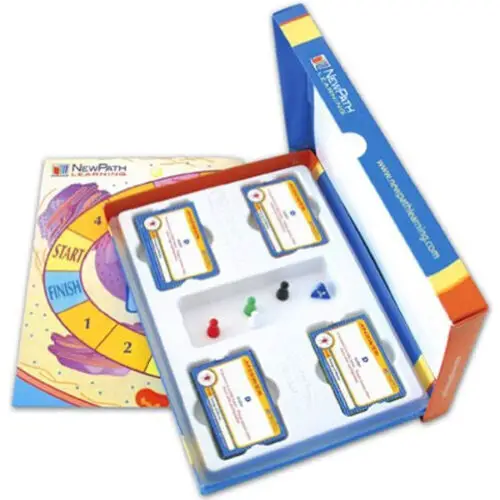
★★★★★
For Schools | Age 11+ | 1-4 players | Price $$$ | Duration 30-45 min
The Biology and The Human Body Curriculum Mastery Game by NewPath Learning features a boxful of information and fun to help review and master human biology. It tackles several learning areas, such as:
by NewPath Learning features a boxful of information and fun to help review and master human biology. It tackles several learning areas, such as:
- Cell biology
- Genetics
- Bacteriology and virology
- Organ systems
- Research
This game set includes a double-sided game board with 250 review cards representing the topics listed above. It is easy to use, although basic (a race game).
There are different editions according to the targeted curriculum, and also class pack and take-home editions
and take-home editions .
.
Scabs & Guts (Outset Media)

★★★★☆
For Families | Age 6+ | 2-10 players | Price $$$ | Duration 30 min
Scrabs & Guts is a “meducational’ board game to teach about the body and how organs work. The game features a scientifically accurate human body that shows internal organs, including the digestive system, lungs, heart, muscles, bones, and brain.
is a “meducational’ board game to teach about the body and how organs work. The game features a scientifically accurate human body that shows internal organs, including the digestive system, lungs, heart, muscles, bones, and brain.
There are 3 categories to play:
- Hygiene, infections, and wounds
- Internal organs and bloodstream
- Positive health choices
There are either multiple choice or true or false questions. If a player answers correctly, they move spaces based on the number indicated on the card. The type of question depends on where they land.
There are two additional types of cards:
- Pick a category: the player can choose what topic to answer.
- Wild card: an action card that tell the player what to do. The other players then decide if the action indicated has been done correctly.
Scrabs & Guts has over 150 cards, which is good for replayability. Question sentences are simple enough that six-year-olds or emerging readers can read them. However, they are at a disadvantage if playing with adults, especially if they are only starting to learn about the human body.
Body Magnet (Janod)
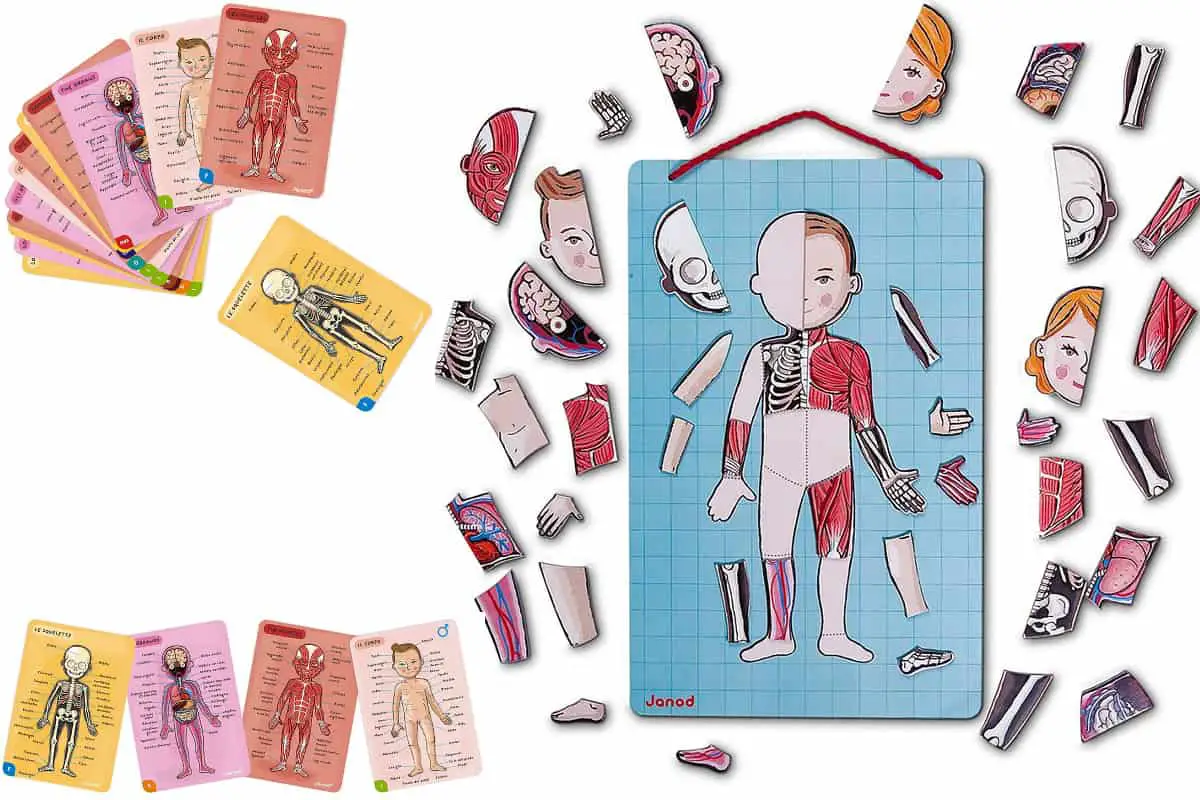
★★★☆☆
For Families | Age 6+ | 1 player | Price $$$ | Duration 10-20 min
Teaching human anatomy to younger children may be challenging because more organs are hidden than seen. But with the Body Magnet , they can finally visualize the internal systems and understand how each connects and works.
, they can finally visualize the internal systems and understand how each connects and works.
Body Magnet is a magnetic board game that allows children to match and assemble the different organs that build up a body system. This game includes:
- Skeletal system
- Muscular system
- Internal organs (brains, digestive tract, lungs, heart, and veins)
- Skin
Detailed guide cards name and explain the different parts of the body systems. There is also a boy and a girl model included in the set.
The 4 guide cards (body, skeleton, muscles, organs) are in 12 languages (24 double-sided cards overall), which is overkill and increases the game’s cost.
The cards also only feature a boy, making it impossible to teach female anatomy, which is a real problem.
Bioengineering Board Games
Strain: A Family Game of Competitive Bioengineering (Copernicus Toys)

★★★☆☆
For Families | Age 10+ | 3-7 players | Price $$$ | Duration 60 min
Strain helps to know how microorganisms evolve and adapt. It can be played by younger learners because the game clearly explains how the processes go. No prior scientific knowledge is required even for the guardians!
helps to know how microorganisms evolve and adapt. It can be played by younger learners because the game clearly explains how the processes go. No prior scientific knowledge is required even for the guardians!
The goal is to complete a microorganism. To do this, you add organelles and cytoplasm and slow down your opponents with viruses and toxins. You may also try to harness a chain reaction for more points. And all you need to do is to outsmart and outbuild your opponents to win.
This game is easy to learn, and a quick play too!
General Biology Board Games
Biology Review Curriculum Mastery Game: Class Pack Edition (NewPath Learning)
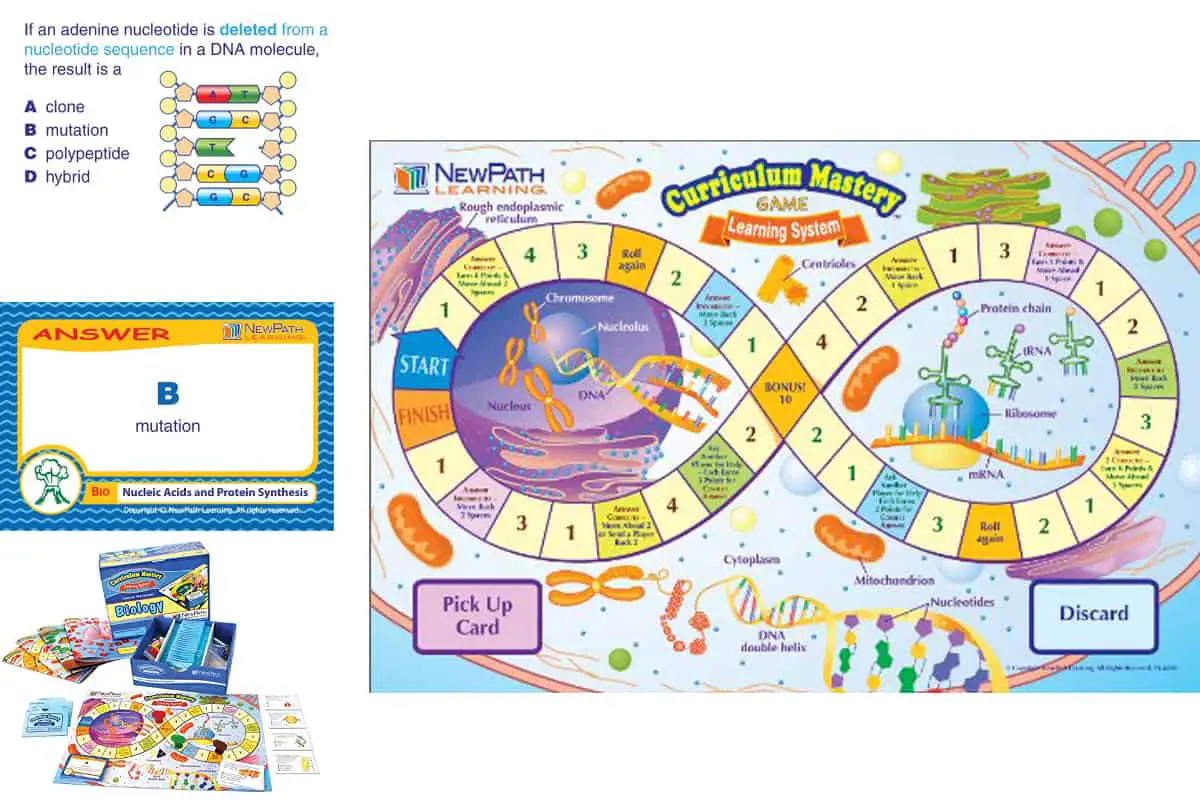
★★★★☆
For Schools | Age 14+ | 1-36 players | Price $$$$$ | Duration 30-45 min
Biology covers many different topics, and it may be a bit expensive to buy a board game for each area of study. NewPath’s solution to this problem is the Biology Review Curriculum Mastery Game , which features over 700 review cards. Each set covers 25 different topics in biology, including:
, which features over 700 review cards. Each set covers 25 different topics in biology, including:
- Cell biology
- Genetics and heredity
- Genetic Engineering
- Evolution
- Zoology and botany
- Human biology
There are 12 double-sided game boards in each box, making this an ideal game even for schools. You can allow up to 36 players to participate simultaneously and learn independently because of the self-correcting review cards. There is also a teacher’s guide included so that guardians at home can aid their children even when they’re not adept in the subject areas covered.
I like this game for the variety of topics that it covers and its self-correcting review cards.
This board game set is also available in a Take-Home Edition .
.
Other Science Board Games to Play with the Family
Science is a complex subject with many complicated concepts that some learners find hard to process and remember. And playing educational board games is a great way to complement their studies while they are having fun. If you want to learn more science board games you can play at home with your family, you may check out 6 Physics Board Games for Families and Schools and 13 Top Chemistry Board Games for Schools and Families
and 13 Top Chemistry Board Games for Schools and Families .
.
Reference
Biology Areas of Study: https://dave4math.com/biology-topics/#General_Biology
Edudingo.com is a participant in the Amazon Services LLC Associates Program, an affiliate advertising program designed to provide a means for sites to earn advertising fees by advertising and linking to Amazon.com. We also participate in other affiliate programs which compensate us for referring traffic.

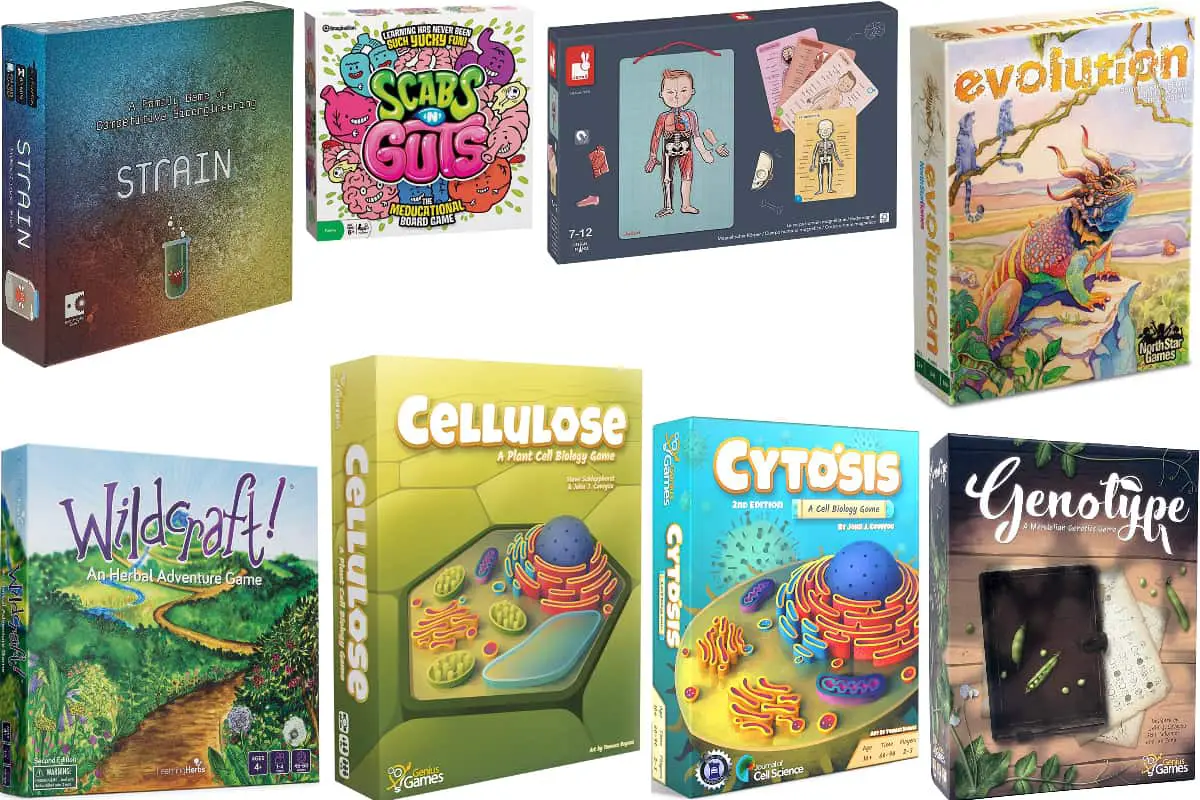
This is a great list with descriptions, so thank you!
I was looking for the printable option to purchase for the Cellulose game that you mentioned above, but I’m unable to find out anywhere. Could you share the link to where I can purchase that?
Thanks again for compiling this list!
Dear Alli,
I checked on the Kickstarter website of the project, and only the regular printed version is available right now (the “Print and Play” option is still shown but inactive as the Kickstarter period is over).
Sorry for that.
Kind regards
François